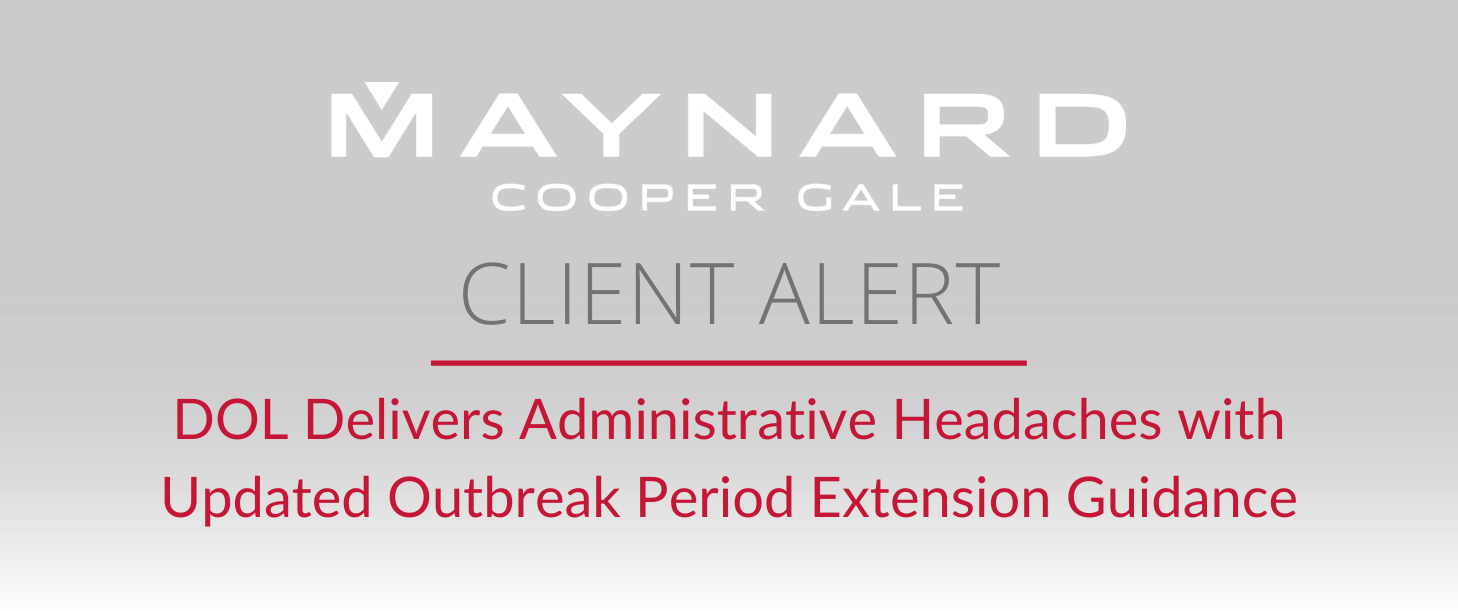DOL Delivers Administrative Headaches with Updated Outbreak Period Extension Guidance

Just as (everyone thought) time was set to expire on the 2020 Outbreak Period Extension guidance released by DOL, HHS, IRS, and the Department of the Treasury, the DOL (in coordination with the other agencies) released EBSA Disaster Relief Notice 2021-1 (“Notice 2021-1”) setting forth a case-by-case approach for determining when each particular extension ends for each particular individual.
As review, in March 2020 in response to the presidentially declared National Emergency due to the pandemic, the DOL and other agencies exercised their statutory authority to extend certain deadlines and timelines for ERISA welfare benefit plans. The deadlines impacted by the 2020 guidance:
- Deadline to elect COBRA;
- Deadline to pay COBRA premiums;
- Deadline to elect HIPAA special enrollment;
- Deadlines to file claims, appeals, and requests for external review; and
- Deadline for plan to provide COBRA election notice
The statute providing authority to toll these deadlines limits the “tolling period” to one year. Although this authority has been used in the past, the disaster relief has never extended to the statutorily-imposed one-year limit. As a result, plan sponsors and the benefits community as a whole had been waiting to see how the agencies would approach this new scenario.
Unfortunately, in Notice 2021-1, the DOL (and joined by HHS and Treasury) chose an approach that effectively provides a separate Outbreak Period Extension for each individual (and each extended deadline for that individual). If earlier, however, all extended deadlines would end 60 days after the announced end of the National Emergency (i.e., the end of the Outbreak Period).
More specifically, Notice 2021-01 provides that with respect to each affected individual the disregarded periods end on the earlier of one year from the date the individual was first eligible for relief, or 60 days after the announced end of the National Emergency. In other words, the DOL’s position is that the extensions apply on a case-by-case basis and extend to one year from the date the particular individual’s extension(s) began, but the extensions will end for everyone on the date that is 60 days after the announced end of the National Emergency (the end of the Outbreak Period), regardless of when the particular individual’s deadline relief period began.
Notice 2020-01 also instructs plan sponsors to consider whether it may be appropriate to provide “reasonable accommodations to prevent the loss of or undue delay in payment of benefits . . . and should take steps to minimize the possibility of individuals losing benefits because of a failure to comply with pre-established time frames.” The DOL suggests that doing so may be part of the plan sponsor’s fiduciary duties because it would be in line with the “guiding principle” for plans to act reasonably, prudently, and in the interest of the workers and their families.
Additionally, Notice 2021-01 also provides that plan sponsors should consider providing employees with an affirmative notice at the end of the one-year relief period and instructs plan sponsors to update notices and communications regarding the various deadlines and extensions, especially if necessary to clarify information previously provided.
The following examples illustrate how this new guidance works in practice:
- If a qualified beneficiary’s COBRA election period began on March 1, 2020, the Notice delays the election deadline until February 28, 2021, which is the earlier of 1 year from March 1, 2020 and the end of the Outbreak Period (i.e., 60 days after the end of the National Emergency), which remains ongoing. In this case, the qualified beneficiary’s 60-day COBRA election period would start on March 1, 2021.
- Similarly, if a qualified beneficiary’s COBRA election period began March 1, 2021, the Notice delays the election deadline until the earlier of 1 year from that date (i.e., March 1, 2022) or the end of the Outbreak Period (i.e., 60 days after the end of the National Emergency). The qualified beneficiary would then have 60 days from that date to make his or her COBRA election.
Likewise, if a plan would have been required to furnish a notice or disclosure by March 1, 2020, the relief under the Notice would end with respect to that notice or disclosure on February 28, 2021. The responsible plan fiduciary would be required to ensure that the notice or disclosure was furnished on or before March 1, 2021.
If you have questions or would like additional information about anything discussed in this Client Update, please contact a member of Maynard & Gale’s Employee Benefits & Executive Compensation practice group.
For more information on The American Rescue Plan Act of 2021 and benefits guidance, see our recent Client Updates:
- Flex Plans are Extra Flexible in 2021
- COBRA Provisions in the American Rescue Plan Act: Time is of the Essence for Employers
This Client Alert is for information purposes only and should not be construed as legal advice. The information in this Client Alert is not intended to create and does not create an attorney-client relationship.
About Maynard Nexsen
Maynard Nexsen is a full-service law firm of 600+ attorneys in 31 locations from coast to coast across the United States. Maynard Nexsen formed in 2023 when two successful, client-centered firms combined to form a powerful national team. Maynard Nexsen’s list of clients spans a wide range of industry sectors and includes both public and private companies.
Related Capabilities














